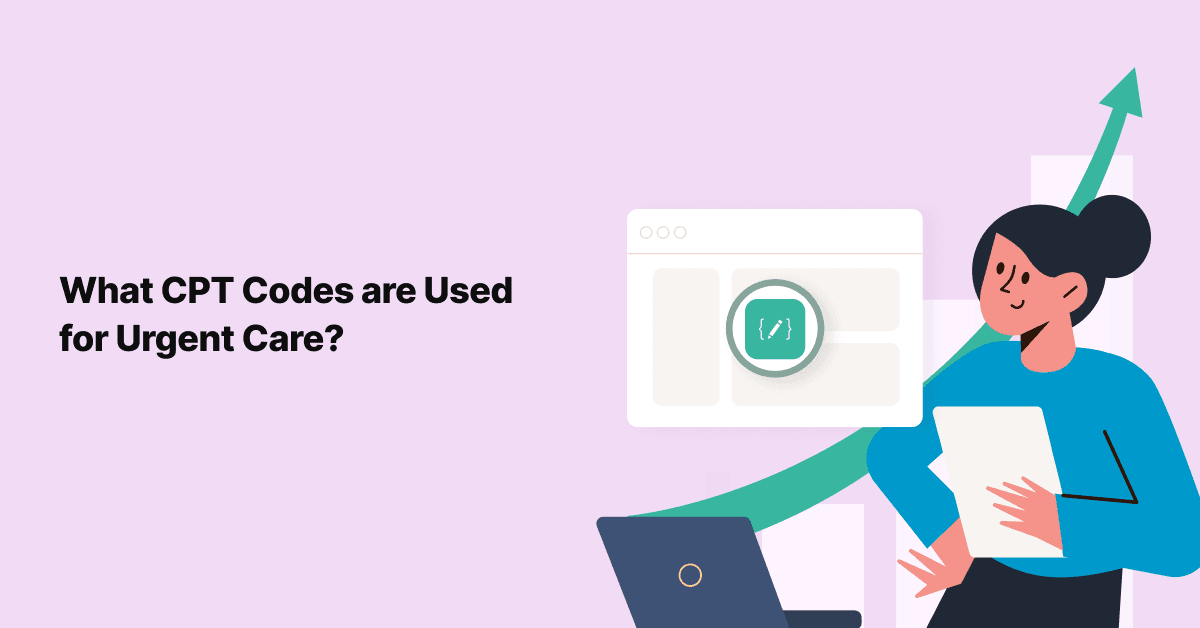
The Ultimate Guide to the Top 14 Insurance Eligibility & Verification Software Solutions
Claim denials, administrative bottlenecks, and revenue cycle friction are more than just daily annoyances for …

Urgent care facilities offer immediate medical attention without the need for an appointment. In fact, according to the CDC, around 26% of adults and 8% of kids visited urgent care centers or retail health clinics in 2021. With such a rising demand, staying updated with urgent care CPT codes can get tricky.
This guide will walk you through everything you need to know about CPT codes for urgent care, the challenges of urgent care billing, and best practices to follow.
Table of Contents
To ensure proper reimbursement for services, urgent care centers need to accurately report their procedures using Current Procedural Terminology (CPT) codes.
These urgent care CPT codes are standardized five-digit codes that cover a variety of services such as evaluation and management (E/M) visits, minor surgical procedures, diagnostic tests, and therapeutic services.
They help explain to insurance companies what kind of urgent care was provided, so your clinic can get reimbursed properly.
Using the correct urgent care procedure codes is important because mistakes can lead to claim denials, delayed payments, or lost revenue. It also helps your facility ensure you get paid accurately and on time for the services you deliver.
Some common issues faced by urgent care centers in coding and billing are:
Knowing these challenges and how to handle them helps urgent care centers improve coding and keep payments flowing smoothly.
This urgent care CPT code list can help you understand which code to use for a specific service, ensuring accurate urgent care billing:
These codes cover patient visits for evaluation and management of a condition. The most commonly used E/M codes of CPT for urgent care visit are:
Urgent care centers often perform procedures like wound repair, suturing, or fracture care. Common CPT codes for these procedures include:
When performing lab tests, X-rays, or other diagnostic procedures, you’ll need to use the appropriate CPT codes, such as:
If your urgent care offers injection or infusion services, common CPT codes include:
Along with traditional CPT codes, urgent care centers often use ‘S’ codes. These codes are used to identify specific services in urgent care settings, and are part of the Healthcare Common Procedure Coding System (HCPCS).
The most recognized HCPCS ‘S’ codes for urgent care billing are:
This code is used to represent a flat-rate billing structure for urgent care services. Some payers accept the S9083 CPT code, which covers all services provided during a single urgent care visit, regardless of the number of procedures or tests performed. However, not all insurance companies recognize 'S' codes, so it’s crucial to verify with each payer before using them.
This code is used to indicate that services were provided in an urgent care setting, allowing the insurer to process the claim correctly. It’s an additional code that helps differentiate urgent care services from those performed in other settings like emergency rooms or primary care.
These ‘S’ urgent care codes:
The American Medical Association (AMA) updates CPT codes every year, and 2025 is no exception. For 2025, CPT has been updated to include 270 new codes, with 38 codes being revised and 112 codes being deleted.
Some of the key changes to urgent care CPT codes for 2025 include:
Here are some tried-and-true CPT code tips for your urgent care center:
Lastly, partnering with an experienced medical coding service like 314e can make all the difference. 314e's urgent care coding services are specifically designed to support urgent care facilities, helping you maximize revenue by providing accurate and up-to-date coding solutions.
With expertise in urgent care CPT codes, 314e can help streamline your processes, reduce claim denials, and ensure compliance with the latest urgent care coding guidelines. Schedule a meeting with our coding expert today to see how we can help your urgent care center thrive.
Join over 3,200 subscribers and keep up-to-date with the latest innovations & best practices in Healthcare IT.

Claim denials, administrative bottlenecks, and revenue cycle friction are more than just daily annoyances for …

Incorrect medical billing, underpaid reimbursements, inability to comply with standards, and threats to …

Revenue Cycle Management (RCM) is a vital but complex process that touches every part of the medical practice. …